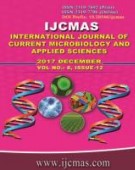


 National Academy of Agricultural Sciences (NAAS)
National Academy of Agricultural Sciences (NAAS)

|
PRINT ISSN : 2319-7692
Online ISSN : 2319-7706 Issues : 12 per year Publisher : Excellent Publishers Email : editorijcmas@gmail.com / submit@ijcmas.com Editor-in-chief: Dr.M.Prakash Index Copernicus ICV 2018: 95.39 NAAS RATING 2020: 5.38 |
Four different antibiotic efflux systems have been described in P. aeruginosa. Use of efflux pump inhibitors (EPIs) improve and potentiate the activity of exported antibiotics. The present study was undertaken to study the role of efflux pumps in drug resistance of Pseudomonas aeruginosa. Total 126 P. aeruginosa isolates from different samples were identified. Antibiotic susceptibility patterns of all the isolates were performed by MIC method. The five antibiotics studied were Ceftazidime, Ciprofloxacin, Gentamicin, Imipenem and Meropenem. Efflux pump mechanisms were studied by phenylalanine argynyl β-naphthylamide (PAβN), a synthetic EPI and by curcumin, a natural extract. By MIC, susceptibility to imipenem was maximum (59.52%). Resistance to meropenem, gentamicin and ceftazidime was > 53%. Resistance to ciprofloxacin was highest (71.43%). After addition of PAβN to all five antibiotics, susceptibility to imipenem, meropenem, ceftazidime and ciprofloxacin increased but susceptibility to gentamicin remained same. Total 22 resistant strains of P. aeruginosa became susceptible after addition of PAβN. Using concentration of Curcumin 50 μg/ml, total seven resistant strains became susceptible with four antibiotics, except with ceftazidime. MIC lowered significantly with addition of PAβN in all antibiotics, except gentamicin, as compared to curcumin. Overall resistance due to efflux pump in multidrug resistant P. aeruginosa was encountered in 14.89% patients. The present study indicates the presence of efflux pump mediated drug resistance among clinical isolates of P. aeruginosa against one or more antimicrobials employed. This study indicates both PAβN and curcumin as potential EPIs, with PAβN being a better one.
 |
 |
 |
 |
 |